Within the Honorable Mention section, I have long published articles detailing defensive gun uses that go beyond the usual average. A specific set of cases are interventions by armed civilians against active killers, of which the column has detailed 54 to date. This article presents an analysis of key aspects of these cases.
Opening picture: Inyat Kassam. The only armed civilian known to have intervened against active killers twice, in 2013, 2019. On both occasions, Kassam confronted terrorists in Nairobi, Kenya.
Type of interventions analyzed
This analysis concerns a very specific range of defensive gun uses. It focuses on interventions against the perpetrators of attacks which, if completed, would constitute a mass murder perpetrated against an unspecified number of persons. In part, these are cases where perpetrators are stopped in the course of committing mass murder, and in part, perpetrators are stopped before the number of victims reaches its definition.
The starting point is the FBI’s generally accepted definition of an active shooter, which is an effort by one or more assailants to murder persons in a public place.
In contrast to the FBI’s yearbooks, this analysis also includes cases where the assailant used a tool other than a firearm, such as an automobile or a knife. Along with the FBI delineation, the analysis does not include cases of targeted family killings and attacks having a broader criminal background (gang shootings, bank robberies, etc.).
All of the cases listed in the table below are detailed in separate articles in the Honorable Mention section, for which sources are thoroughly cited. Unfortunately, the mass media focuses primarily on reporting on completed mass murders. Cases of successful stopping of active killers are often under-reported , often only as part of short local news stories. Detailed follow-up analyses are usually only available in cases where the attacker is stopped after a large number of people have been murdered. In cases where an active attacker is stopped at the very beginning (or even before managing to injure anyone), the information available is minimal.
Thus, the list below cannot be considered a comprehensive list, but only a selection of cases for which information is relatively easy to trace from publicly available sources.
The table also includes selected cases of rescue of police officers by armed civilians. These are not considered for the analysis below.
Success rate of armed civilian interventions
78% of zbrojnice.com Czech readers carry a concealed firearm for personal protection. Naturally, the first point of analysis must be to answer the question of the success rate of armed civilian interventions. In general, the perpetrator of a crime chooses the victim, the place, the time, the manner and the instrument of commission. In the case of active killers, long-term planning is the rule, with lengths in excess of a year not at all exceptional. What chance, then, does have an armed civilian who goes about his daily business and happens to be at the scene of the attack?
To answer this question, however, it is necessary to determine what we consider a successful intervention against an active killer. In general societal terms, this will be the rescue of potential victims regardless of the consequences in the realm of the armed samaritan. On an individual level, however, many people may perceive it differently. They have a duty to protect their loved ones first and foremost – and if they lose their health or life in an attempt to save strangers, they cannot then fulfill that primary duty.
Success rate through the eyes of an independent observer
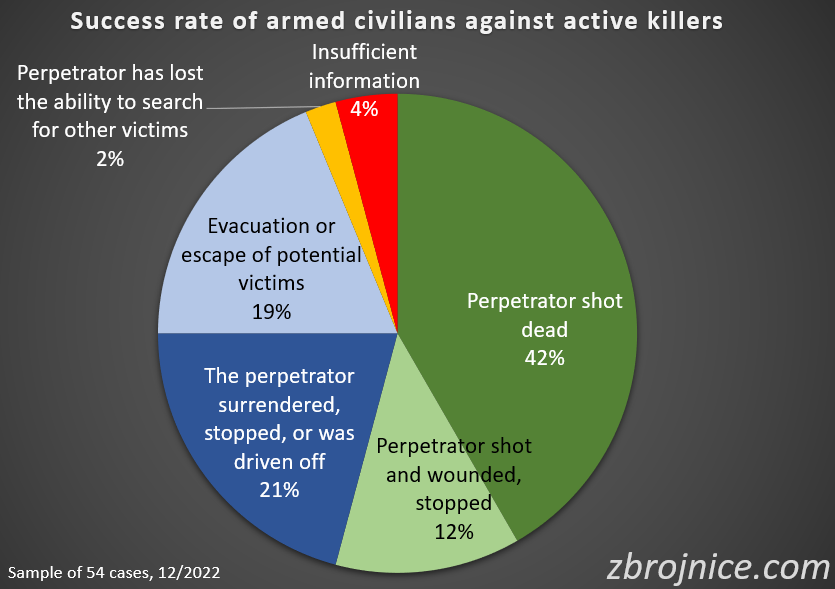
From the perspective of an independent observer, we can state that 96% of the interventions by armed civilians were unequivocally successful. 75% of the interventions led to the stopping of the attack, while the other 21% led to the rescue of potential victims without the perpetrator being stopped (i.e. the perpetrator was subsequently neutralized by the police).
Details of the tactical approach of the intervening civilians can be read in separate articles, which are categorised by type of attack site for clarity. With no ambition to create a detailed overview among the successful interventions, the following significantly stand out:
- Charl van Wyk, a missionary who, with only a revolver, successfully confronted four terrorists that were armed with assault rifles and grenades, saving approximately 1,000 people (the terrorists confessed that they wanted to shoot as many people as possible in the church, and then burn all the remaining people alive).
- Resistance by a group of armed civilians against the terrorists in Westgate, who helped evacuate approximately 600 people from the perpetrators’ reach while police waited outside for the arrival of the SWAT team.
- Instances of stopping significantly better armed perpetrators in mere seconds (e.g. Jeanne Assam, Elisjsha Dicken).
In two cases, there is insufficient information for a definitive assessment and they are therefore listed as ‘insufficient information‘.
- Aaron Salter Jr, a retired police officer, was working as a private security guard for a supermarket at the time of the attack. The assailant expected his presence and the uniformed Salter was his only targeted victim in addition to trying to murder as many other people as possible. Salter still managed to fire four shots, one of which hit the perpetrator’s ballistic protection. The assailant had originally planned to relocate and continue his killing elsewhere, but he had failed to do so before police arrived. Some sources attribute the confrontation with Salter to a delay that prevented the attacker from relocating.
- Byron Wilson was shot and seriously wounded by the perpetrator. Available sources differ as to whether he was able to take active action against the perpetrator. According to the original police report, he took aim at the perpetrator, whereupon the perpetrator retreated from the street into cover and did not seek out other victims outside of cover. The attacker was later stopped by a police sniper 55 minutes after the attack began.
The following case is referred to as “loss of opportunity to search for other victims”:
- Mark Alan Wilson intervened against the perpetrator outside the courthouse at a time when the officers present at the shooting had withdrawn to retrieve better firearms and wait for backup. Wilson hit the perpetrator twice perfectly, but he did not know that the perpetrator was wearing a bulletproof vest under his clothing. Because of the confrontation with Wilson, other possible victims fled, and police subsequently arrived. Wilson died, but from the perspective of an independent observer, he successfully saved the lives of other potential victims.
A few successful interceptions of active killers by unarmed civilians are listed as honorable mentions, but not used in statistical comparisons, such as Robert Caleb Engle overpowering an active assailant – a bodybuilder, or John Sawchuk disarming a school shooter. Also quite unique was the intervention of John Stewart, who, unarmed through sheer force of determination, drove an active killer out of a synagogue – but himself subsequently survived only thanks to the shooting of armed civilian Jonathan Morales. In general, successful interventions by unarmed civilians against active killers are extremely rare.
In the cases studied, it can be deemed certain that the intervening armed civilians saved more than 2,000 lives, and likely that they saved something in the region of 3,000 possible victims.
Survival rate of armed samaritans
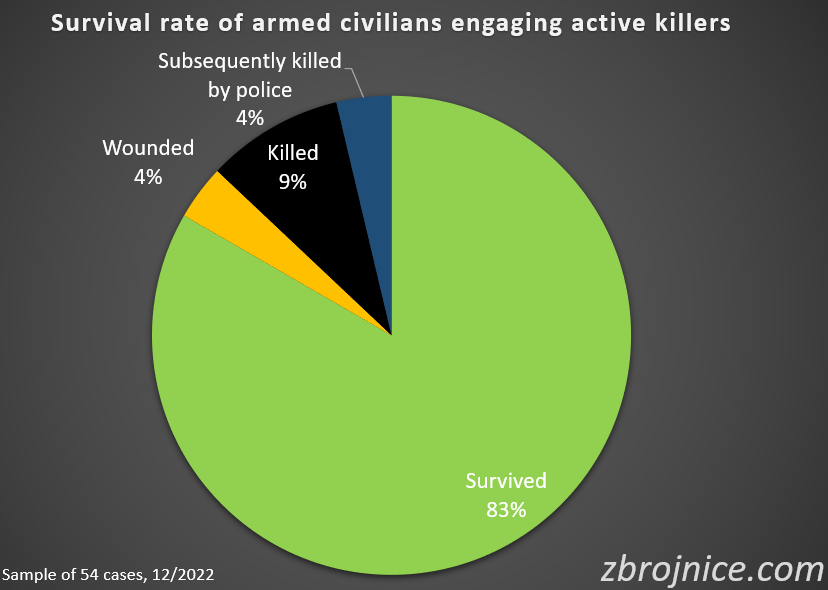
The second possible perspective on success comes through the eyes of the armed samaritan themselves or their bereaved family. If the intervening civilian stops the attacker but ends up paralysed or dead, from the perspective of their relatives, it is probably not a successful intervention.
In total, 83% armed samaritans interventions came out unscathed. The remaining cases can be divided into three groups: injuries (both very serious), death by the perpetrator and subsequent death by the police.
Two armed civilians who intervened suffered injuries. In both cases, they were persons who would not otherwise have been in immediate danger and could have chosen to leave the scene of the attack instead of confronting the perpetrator:
- Byron Wilson, whose case is summarized above. Wilson underwent a series of surgeries that were not covered by insurance and that he had to pay for with donor money. Doctors at the time said it would be at least 2 years before he would be able to walk again. I have not been able to track down a more recent report on the progress of his condition.
- Brendan McKown intervened against an active assailant at a mall. The deeply religious McKown hesitated because the attacker appeared childlike, whereupon the perpetrator shot him. McKown ended up paralyzed in a wheelchair; the perpetrator ceased his attack after hitting McKown.
The following armed samaritans died at the hands of the perpetrators:
- Aaron Salter Jr. whose case is described above (supermarket).
- Ari Fuld was the first accidental victim of a Palestinian terrorist. He managed to shoot his attacker before succumbing to injuries, which prevented the attack from having more victims.
- Both Salter and Fuld were in a desperate situation and had no way of avoiding the attack themselves.
- Richard White watched a suspicious man in the church for several minutes, slowly closing in on him. But he then didn’t have time to draw before his attacker hit him with a shotgun blast. The assailant was then shot by another armed civilian, Jack Wilson.
- White had identified the threat ahead of time and presumably could have withdrawn from the scene, but in doing so he would have left his family and friends at the mercy of his attacker.
- Joseph Robert Wilcox confronted the perpetrator of a supermarket attack. At gunpoint, he urged him to surrender. He was unaware that the attacker’s partner was also at the scene and subsequently shot Wilcox from behind. Due to Wilcox’s confrontation of the attacker, a number of potential victims fled the store.
- Mark Alan Wilson, whose case is described above (area outside the courthouse).
At the time of the attack, Wilson purposefully walked out of his apartment onto the street to confront the perpetrator. Wilson, and Wilcox probably too, could have avoided confronting the perpetrator.
The following were killed at the hands of police officers:
- Jemel Roberson had driven off an active assailant in a bar. He shot him and apprehended him. While local police officers were administering first aid to the wounded, an overzealous officer from the next county arrived and shot Roberson (a black man), who was kneeling and holding down the perpetrator.
- Roberson worked as a security guard at the bar. He had no choice at the initial moment, subsequently he could have let the shot perpetrator escape, but still apprehended him in accordance with his profession.
- John Hurley stopped an active assailant in the square. The first officer to arrive on the scene then shot Hurley dead.
- Hurley was in a tourist shop where he could have continued to hide safely from the attacker or could have left the location in a safe direction.
Related: A guide for police officers: what to think about when dealing with armed civilians
In the above cases, it can be assumed that the intervention of armed civilians led to the rescue of at least 60 people, potentially between 100 to 200 people. That even though the armed samaritans themselves ended up dead or seriously injured.
Time for an armed samaritan to react against an active killer
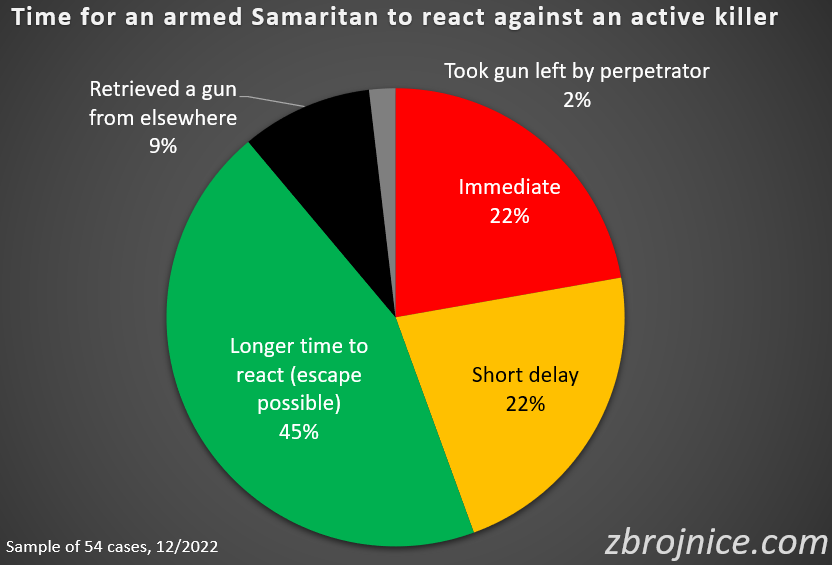
In terms of determining shooting training, it is essential to know what time space an armed civilian can expect before confronting the perpetrator.
- Immediate Response (22%, red). The armed civilian had to react immediately without the ability to plan or choose response tactics. Typically, in these cases, the intervening civilian themselves were directly threatened and did not have a safe retreat option.
- Short delay (22%, orange). The armed civilian had to react very quickly, but had at least a few seconds (up to 15 sec) to choose their tactical course of action. As a rule, in these cases they were themselves threatened and had no possibility of safe retreat.
- Longer reaction time (45%, green). In these cases, the armed civilian was close to the point of attack. Generally, they were not immediately threatened and had the alternative of a safe retreat, but instead chose to confront the attacker.
- Persons who had to run to retrieve their weapon first (9%, black) had even more time and an unquestionable opportunity to escape the attack. This included retrieving the weapon from the car (Gross, Bridges, Myrick) or from a house adjacent to the scene of the attack (Strand). The situation of Jonathan Morales was specific, as he used a gun stored in a synagogue for these purposes (local California gun legislation did not allow carrying for self-defense).
The intervention of Abdul Aziz is quite unique. He picked up a shotgun from the ground that the active assailant had earlier discarded. Although the shotgun was unloaded, the mere pointing of it at the perpetrator was enough to drive him away. Aziz was thus a semi-armed civilian for only about ten seconds, but even that was enough to end the attack.
The level of preparedness of the intervening samaritans
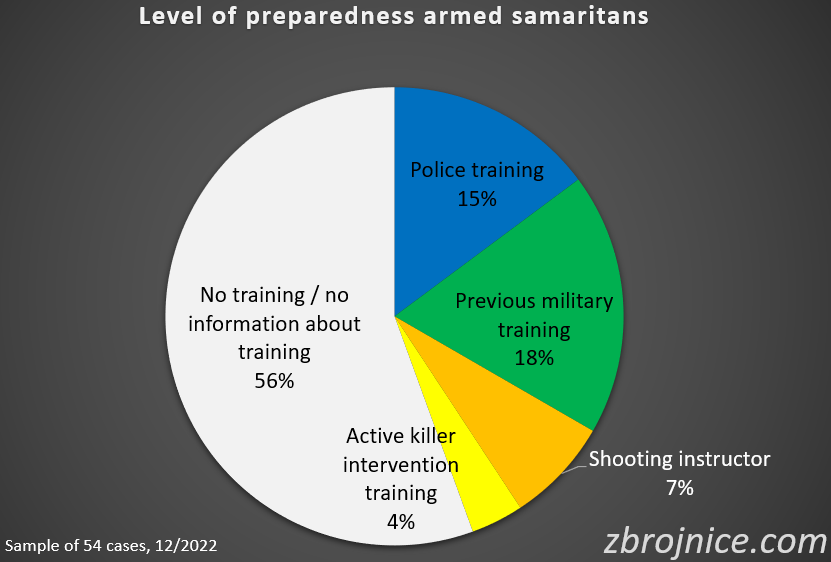
The level of preparedness of armed samaritans is usually a completely neglected issue in the mass media articles. For the majority of intervening civilians, we do not have this information at all (56%). Exceptionally, the complete absence of advanced training is explicitly mentioned (Elisjsha Dicken). In some cases, it is known that they were shooting instructors (7%, including 2 cases of Inyat Kassam) or that the intervening civilian had previously sought out and received active shooter engagement training on his own (David George, Juan Carlos Nazario).
On the other hand, when it comes to the intervention of an off-duty police officer, former police officer or ex-soldier, the media devotes quite a lot of space to such information.
Specifically, in the case of the interventions in Israel, this fact in the table is assumed in relation to all armed civilians, even if it does not follow from the source articles. Until recently, the issuance of a permit to carry a weapon there was conditional upon prior qualified military service.
Individual cases in terms of numerical superiority
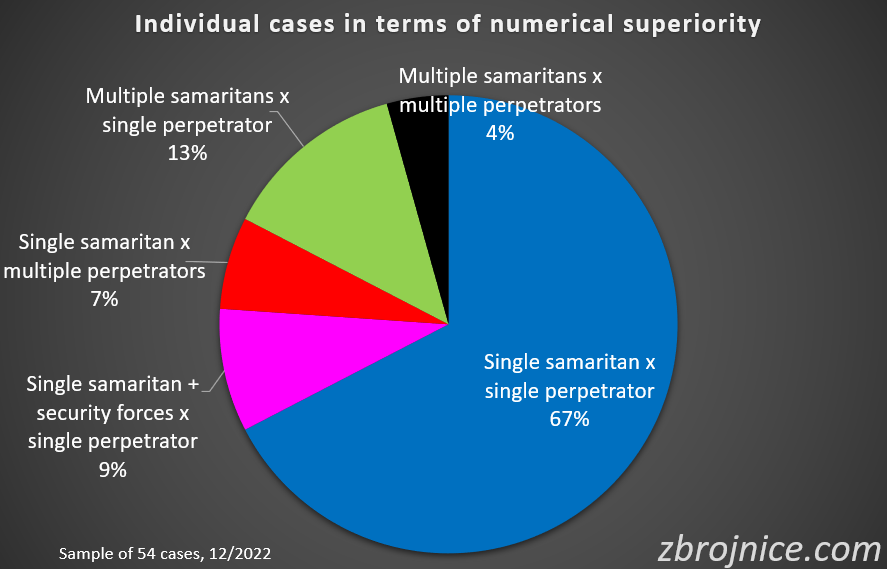
From a practical point of view, information regarding the numerical superiority of armed samaritans, or attackers, in individual cases is also useful. For this statistic, engagements by multiple civilians within the same case are counted as only one engagement, i.e., 7 civilians engaging in Westgate against a group of terrorists carries the same weight as a 1v1 engagement in this graph.
Two thirds were cases where a single armed samaritan intervened against a single attacker. In the other 9%, the intervention of a single samaritan took place in the presence of security forces, either because it was faster (Eitan Rund), or in direct cooperation (Yitzhak Dadon), or against the background of ineffective police intervention (Nenad Kaluđerović).
A lone samaritan faced multiple attackers in three cases (7%), two of which occurred in South Africa (Charl van Wyk, Pieter van der Westhuizen) and ended successfully. The third occurred in the USA (Joseph Robert Wilcox, described above).
On a total of six occasions, two armed samaritans faced a single attacker together (13%). Five of these were joint actions, although in at least two cases they did not know each other at all. On one occasion, two armed civilians acted independently against an attacker from different directions (Bryan Whittle & Juan Carlos Nazario).
Two cases of multiple armed civilians acting (partly independently) against multiple armed attackers are quite specific. This occurred against the backdrop of the terrorist attacks in Nairobi, Kenya. Westgate in 2013, when the police set up an outer perimeter and waited passively for several hours for a SWAT team to arrive. In 2019 in Riverside, when the intervention occurred against the backdrop of an ongoing police operation.
There are no known incidents where armed samaritans have shot each other, members of the armed forces or bystanders.
Geographical distribution
A prerequisite for the possible intervention of an armed civilian at the scene of an attack is, of course, his presence. Accordingly, the geographical distribution of the cases in the list corresponds to places where civilians are legally able to carry firearms for personal protection. The majority of cases come from the USA, with Israel and South Africa also repeatedly represented.
Specifically in the USA, an increase in the number of interventions by armed civilians can be traced to changes in legislation and the practice of concealed carry. By 2010, there were still fewer concealed carry permits per capita in the US than in the Czech Republic, while now, 12 years later, anyone who legally possesses a gun can carry it in half of the country without needing a special permit.
By contrast, in the European Union, at the height of jihadist activity, over 380 people were murdered between 2012 and 2018, exclusively in countries where legislation prohibits the carrying of weapons for personal protection. There is no known successful intervention by a civilian against an attacker from this region. All terrorist attacks in the European Union have involved the use of illegal firearms, mainly smuggled from the Balkans, or other means (e.g. Nice truck attack, 86 murdered). Firearms restrictions affect potential victims, but are routinely circumvented by attackers.
The value of armed civilians to public safety
Legally armed civilians are an effective means of countering active attackers. After writing and analysing detailed accounts of 54 cases of armed samaritans intervening against active killers, I draw the following conclusions:
- Active attackers strike most victims in the opening few minutes. After that, further potential victims have already run away or try to hide. The second phase involves searching, with the number of victims generally increasing more slowly. The speed of the intervention is crucial, regardless of whether it is done by a civilian or a police officer. Even a relatively short delay of a few tens of seconds due to a confrontation with an armed samaritan can give potential victims enough time to get out of the killer’s reach (see the cases of Mark Alan Wilson, Joseph Robert Wilcox).
- In addition to the legislation, the actual practice of concealed carry is also important for a statistically significant probability of a successful intervention. The presence and intervention of an armed civilian in public places becomes statistically significant as the adult population that actually carries guns in real terms increases.
- Another important factor is the general social and legislative ethos. The threat of prosecution for a successful, albeit less than perfect, intervention against an active assailant is a major deterrent.
- Armed civilians can be successful in even the most extreme situations imaginable. Charl van Wyk was apparently one of three armed civilians in a church that was stormed by four terrorists. Missionary van Wyk fought them off with a revolver shot, while the second armed civilian died before he could react; the third did not do so for unknown reason.
Conclusion
As recently as 2018, it was common in the Czech mass media to find the thesis that there were no cases of armed civilians stopping active attackers, or that armed civilians are generally not capable of doing so at all.
This view became marginalised in the Czech public discourse thanks to an earlier version of this article. Not only that, by virtue of Act No. 14/21 (the number refers to the 600th anniversary of civilian firearms possession in the country), there are nowadays state-approved training courses of armed civilians, which include, at the second level, training of engagement against an active killer.
I firmly believe that the above statistical summary, as well as the individual articles in the Honorable Mention and Self Defense sections, are of benefit not only in the context of training intervention against an active assailant, but also to the rest of the armed public.
If you know of other cases of armed civilians intervening against active killers, please post them in the comments below.
The author would like to publish interviews with armed samaritans, but so far his efforts to contact them have been unsuccessful.
This article is an English translation of a Czech original published by the author on zbrojnice.com on 24 December 2022.


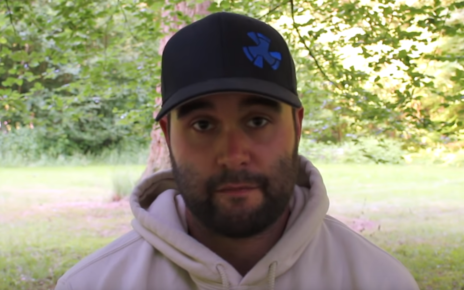

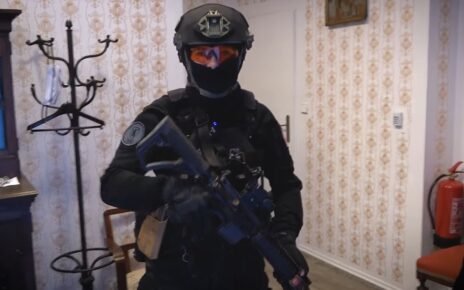
This is the oldest incident that I have found. I include it because it is in the “modern era”. It occurred in 1915, in Brunswick, Georgia. It is a bit unusual in that 20 or more people were wounded and at least five killed. The citizen who finally stopped the slaughter obtained the pistol used from a hardware store, during the attack, after he had been wounded. The shotgun was actually a double barreled model.
Angered by losses in a real estate deal, Monroe Phillips, a lead business man, ran amuck today with an automatic shotgun and killed five men and wounded twenty others before he himself was killed. Phillips was shot dead by E.C. Butts, a lawyer, while he was trying to fire upon citizens who appeared in the street.
http://query.nytimes.com/gst/abstract.html?res=9F04E6DE153BE233A25754C0A9659C946496D6CF&url=http://timesmachine.nytimes.com/timesmachine/1915/03/07/104231113.html
I have more incidents. A direct email would facilitate communication.
Using the comment section is awkward. This is my third attempt.
Dean, many thanks for your comment. I am sorry for any issues with commenting here. First comment always needs to be approved manually, then the same combination of name and email remains auto-approved for future comments.
I will definitely contact you directly. I will be looking forward to extend my library of detailed articles on active shooter engagements.
Dear Tomas.
I allowed myself to translate your article about good&armed Samaritans into polish and put it into polish internet.
Link :
This text should be the real eye-opener for whole progressive Western Europe. Especially for those wo have power to perform any changes in keeping and bearing arms by law abiding citizens.
Unfortunately in Poland gun possession is a very precious, and strictly controlled privilege.
In polish mainstream, gun access for ordinary people (doesn’t matter whether for self-defense, hunting or sports shooting) is treated as, one said, “fringe issue”.
There are simply too few gun owners and they are too inert and divided, to became real social power and start effective fight for their rights.
Best regards and greetings for all gun enthusiasts in Czech Republic.
MR
PS: Best regards for Dean from GUNWATCH also.
Link to te article on Trybun blog :
https://trybun.org.pl/2022/12/30/idea-dobrego-samarytanina-w-analizie-incydentow-z-udzialem-uzbrojonych-cywili-przeprowadzonej-przez-czeski-portal-zbrojnice-com/